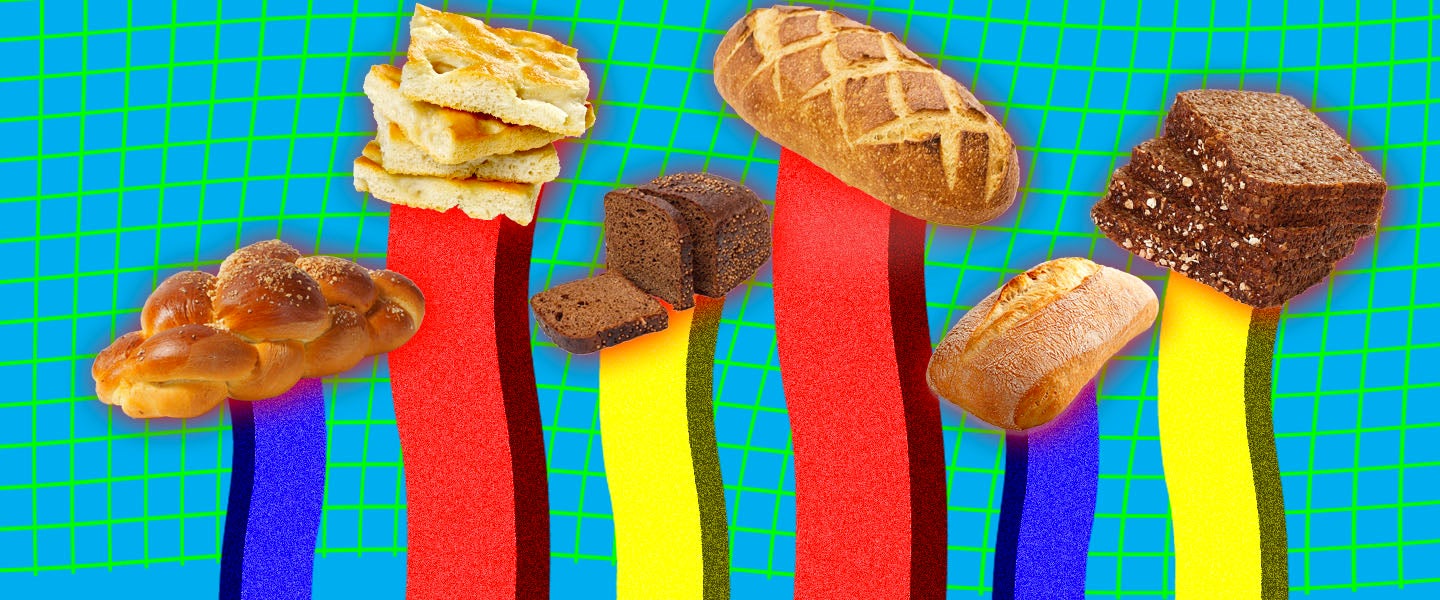First, a friendly trigger warning for anyone on the keto diet: Science shows that consuming carbohydrates in moderation is healthier than consuming them either in low amounts or not at all, which means bread isn’t actually the devil. That said, not all breads are created equal, which is why I asked Dana Hunnes, senior dietitian at the Ronald Reagan UCLA Medical Center, to help me rank every type of bread — from healthy to pretty damn unhealthy.
But first, here’s the method behind our ranking: “Generally speaking, the healthiness of bread is derived from two things: The type of flour used (which means the percentage of whole-grains used), and some of the more minor ingredients added, including butter and eggs,” Hunnes explains.
With that, let’s get this bread…
1) Whole Wheat Bread: “If we’re talking about 100 percent whole wheat bread, you get a good amount of fiber and protein from that whole grain,” Hunnes says. “Whole grains, including whole wheat, are also the least processed of all grains.” Nutritionist David Friedman, author of Food Sanity: How to Eat in a World of Fads and Fiction, previously told me that he seconds this notion: “It’s loaded with fiber, healthy plant-based protein, vitamins, minerals and a variety of phytochemicals that help to improve digestion, reduce inflammation and lower cholesterol,” he explains. “Whole-grain bread also contains lactic acid, which promotes the growth of ‘good bacteria’ in the intestines.”
2) Multigrain Bread: “Multigrain breads tend to contain ‘some’ whole grains, although not always — eating multigrain bread usually makes you feel good about yourself, but multiple refined-grain flours can be used to make this bread,” Hunnes explains. Refined grains are stripped of their fiber and micronutrients, and have been linked to overeating and obesity. “However, multigrain breads are still healthier than white bread.”
3) Sourdough Bread: “Sourdough tends to be healthier than white bread, although it’s also made from white flour,” Hunnes says. “What makes sourdough slightly healthier is the fact that it’s made from a fermented yeast product — fermented foods tend to be more of a prebiotic [foodstuff] for the probiotics inhabiting our intestines.” Friedman also recommends sourdough bread for those who are gluten sensitive. “Sourdough utilizes natural fermentation, which breaks down the gluten,” he says.
4) Rye Bread: “Any additional healthiness from this bread, over straight-up white bread, might come from using rye over white wheat flour… and perhaps the fermentation process caused by the yeast,” Hunnes explains.
“A study published in the Nutrition Journal shows that rye bread can help decrease hunger for up to eight hours,” Friedman adds. “Another study published in PLOS Medicine found that whole-grain rye toast lessens blood sugar surges.”
5) Challah: “This bread usually has egg in it, which is a boon in terms of protein — although, it doesn’t provide much,” Hunnes says, adding that this is, more or less, another form of white bread with a little extra protein from the eggs.
6) White Bread, Ciabatta, Focaccia and Baguette (tied): “These are all, more or less, a riff on the same recipe,” Hunnes says. “Sometimes, though, ciabatta and focaccia have added fats, which can affect how healthy they are.” More specifically, Friedman says, “Consuming white bread can cause a spike in blood sugar, weight gain and inflammation.” That’s because, similar to refined grains, adding white flour — which is used to make white bread — is the absolute worst, since the bleaching process that it undergoes strips away all of the nutrients.
7) Monkey Bread: “This is a dessert bread as opposed to a savory bread, and given the high sugar content, I would rate this last,” Hunnes says.
So much for my regular monkey bread cheese steak lunch, then.

